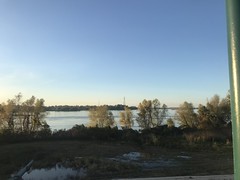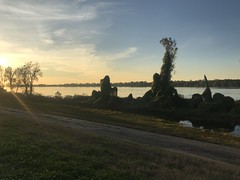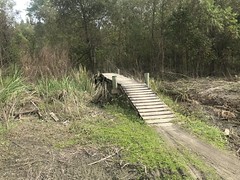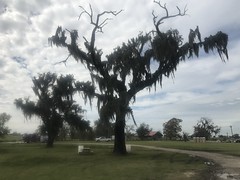It rained last week, all week. The week before, it also rained, all week. Last weekend, however, for some reason, it did not. How fortunate for me!
Like the previous weekend though, I could either ride forest roads, or go for a walk, and the latter struck me as more likely to be fun, so that's what I did. I honestly don't remember what made me want to explore the specific area that I did, but I do remember thinking that it was a great idea, and that I didn't want to go anywhere else.
The place in question is John Dick Mountain. Or, rather, the pair of mountains - Big John Dick Mountain, and Little John Dick Mountain.
If they don't sound familiar, that makes sense. They aren't very well known these days, but that wasn't always true.
I drove in on an unusual route - up 400, over to FS28-1, up 77, over Winding Stair Gap, down FS58, and out on FS58E to the campsite at whatever that creek is up there. I really should have taken 575, Hwy 52, and Big Creek Road out, but for some reason that didn't occur to me until I was already committed to the other route.
I haven't been up to the Blue Ridge for a while, and I almost missed fall. Not quite though. Not quite. There were still some colors on display as I climbed FS77.

It wasn't amazingly gorgeous, but I was glad that I got to see something.
As I mentioned earlier, I drove up FS58E and parked at that campsite. FS58E isn't usually open, but it is this time of year, for deer and bear season. What luck!
Just up the road from that campsite, there's a trail leading up little John Dick Mountain. 15 years ago, I hiked a good ways up that trail, but gave up when it became indistinct. Why try it again? Several reasons... First: Since then, I found a series of historical topo maps show a network of trails leading every which way up there. The trail I'd followed was one of them, and the maps showed it leading all the way up to the top of Little John Dick Mountain. Second: I recently got a copy of "Sound Wormy", Andrew Gennett's memoir, and he mentions regularly riding his horse Ribbon to the top of John Dick Mountain to survey his Fannin County logging lands, so I had decent reason to believe that those trails did exist during the time frame that the old maps were printed. And, third: I'm a lot better at following old, forgotten trails than I was 15 years ago.
Right away, I noticed that the trail had, at some point, been maintained as a road or a firebreak. There were several turn-outs that I hadn't noticed before. I found an old road crossing it too, that I'd seen on Google's lidar layer. Stuff I hadn't noticed 15 years ago.
One thing I did notice 15 years ago though, was that the trail followed the WMA boundary. Or, I guess, more precisely, that the boundary followed the trail, as the trail predated the WMA.

I found plenty of markers this time too.
At a point, the trail leveled off, and became less and less distinct, as an obscure trail along a level bit of ridgeline is wont to do. I did see a couple of overgrown sidehills here and there, suggesting a logging network.
And if there was any doubt that the area had been logged, this old cable set that doubt to rest.

It looked like the area had been logged ages ago, completely recovered, and been logged again at a lower elevation. I wonder if the forest service has records of who logged what, and when.
I also found a bunch of reflective ribbons marking the route.
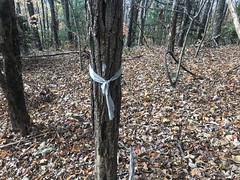
The Rangers use those. Between those and the WMA signs, it was pretty easy to tell which way to go. Of course, it's also just generally easy to climb to the top of a mountain - you just go uphill until you get to the top.
Even without the WMA signs, or the ribbons, there was a generally discernible corridor leading up the ridge, and the ground in it was generally more solid than the ground to the left or right, but it was clear that if there was a time that people went that way regularly, it was definitely a long time ago.
I made it to the top of Little John Dick Mountain in good time. There was no discernible trail or corridor leading up to it though. Along the ridge itself, the brush was parted. A game trail maybe. Some old maps show the Benton MacKaye running across that ridge though. I don't know if it ever really did, or if the old maps just generalized its route. I've seen trails get rerouted, and I've seen maps just be wrong. Who knows?
I mentioned earlier that the John Dick Mountains weren't always as obscure as they are today. These days, if you're riding the Noontootla Loop, they loom distinctively on the ridgeline to the left, as you head back toward home on Doublehead Gap Road. The Benton MacKaye trail also skirts them. People camp sometimes at Bryson Gap between them, and there's a spring downhill to the east. But, that's about it.
In antiquity, at least according to Andrew Gennett, Cherokee Chief John Dick had a house and a farm on top of the mountain. Specifically, a peach orchard. John Dick lived there, and Gennett alleges to have eaten "indian peaches" from the trees that were planted 100 years prior to his arrival. Around Gennett's time, the whole Blue Ridge WMA was as populated as the rest of North Georgia. As far as I can tell, there were two main settlements - Hickory Flats and Argo. Hickory Flats was basically the whole area between Long Creek and FS42, from Noontootla Creek to No-Name Ridge, and Argo was everything north of Hightower Gap, in the Rock Creek watershed. There were 50-odd settlements in the Argo area, and probably fewer in Hickory Flats, but still, quite a few. To the south, the Blue Ridge loomed over these settlements. The John Dick Mountains would have towered above them to the north. I imagine they would have been iconic to the locals, at the time, in the way that Sawnee Mountain is to Forsyth County locals today.
John Dick Mountain is actually made up of three knobs. Gennett's memoir doesn't mention which of them the farm or house was located on, but I planned on hitting all three of them, if I could.
Big John Dick was visible ahead of me, a little east of north.

I followed the trail for as long as it was discernible. It became indiscernible in the vicinity of this biggish oak.

From there on, I was bushwhacking until I hit Bryson Gap.

The old road to the north there had been blocked, since I was last up that way. And, intentionally so, it appeared.
There was a reasonably discernible old road leading directly up Big John Dick from the gap, with multiple side trails. It resembled a logging network. This didn't surprise me, considering the extensive network I'd found in the Alec Branch valley to the north west. Old maps show the BMT taking that route over the knob too, so it may have once followed the old road. It didn't go all the way up though, or at least I couldn't discern where it did, if it ever had.
Near the top, there was another pair of largish oaks.

And at the very top, an old campfire ring.

There was modern trash up there too, so I guess I wasn't the only one adventurous enough to make it to the top recently.
It had been sunny earlier, but clouds had been rolling in all day. To the north though, there was a break in the cover and a bright ribbon of sun on the farms and fields in that direction.
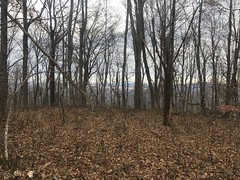
I tried hard to get a photo of it, but I could capture anything that matched how striking it was in real life.
A vague trail led north toward Sapling Gap. I'll have to check that out someday. I headed east though, following another vague trail heading in that direction.
At the gap, there was an old orienteering marker.


The Rangers placed those all over the forest, eons ago. There are multiple generations of them. The most modern are highly reflective, yellow diamond road-sign-looking things, and they look like they were produced in a factory somewhere. Older ones were bigger, made out of 3/4-ply and painted yellow. Their shape is hard to explain. From above, they would look like a plus-sign. From the front or side, they were square. Older still are just squares, diamonds, or circles of plywood, usually painted yellow, but I've also seen red ones. And, I think the oldest ones are yellow ammo boxes. This one has definitely seen better days. Over the years, I saw many of the plywood markers either been removed outright, or replaced with more modern signs. I had a map once with the locations of all the ones that I had found, but then they started moving/removing them, and I quit keeping track. I'm not sure they really know where some of them are though. Like this one. Seems like it's due for removal or replacement.
The knob to the east was easy to explore. The woods was wide open up there.

I didn't see a discernible trail, but you wouldn't really need one either.
Oh, yeah. It was cold up there too.
Some water was seeping out of this tree here, and freezing as it seeped.

Wanting to get out before dark, I'd been keeping an eye on the time, and I'd been pushing it a bit. It was definitely time to get back.
As often happens though, I found a nice-looking side trail on the way back, which led to others, and others, and I ended up going back a very different way than I'd come in. I ended up on the BMT for a while, then ended up sidehilling off-trail for a while, believing I'd recognize the ridge that I came in on. Well, I didn't, and eventually ended up on a parallel spur, heading the right direction, just about 1/4 mile to the north of where I wanted to be. Somehow I also managed to just barely miss hitting FS58E, and didn't discover exactly where I was until I hit a crossing trail, near a bunch of indian graves.

Those, I recognized, distinctly. And, my goodness, I was off track. I'd descended some several hundred feet below the road my car was parked on and would have to climb back up. Fortunately I finally knew where I was. Unfortunately, I knew exactly how tough of a climb out it would be. Doubly unfortunate was how much deadfall had accumulated on one of the trails since I'd last hiked it. I'd originally marked it as an "adventure" trail on my map, but it has definitely degraded to "reclaimed."
I did make it out though, and even made it out roughly on time. I took the correct route home, grabbed some Shane's in Ellijay, and made it home in good time to watch New Orleans beat Cincinnati.
Woohoo! Adventure and another win. What a day.







